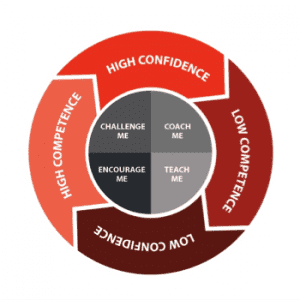You Never Outgrow Your Responsibility for Talent Development
“Why doesn’t anyone care? Don’t they get it? There’s no one I can trust or depend on!” We have heard those frustrated words from more than one senior leader across a range of industries. If you’ve ever heard this or said it yourself, it reveals a severe problem in your talent development and, ultimately, the future of your business.
When a crisis hits or a “move now” opportunity presents itself, you don’t have time for talent development. You’ve got to respond. If your business context is legitimately a series of crises or opportunities with short windows, having the right people equipped with the right skills become even more important.
When leaders struggle with talent development and feel as if there is “no one who cares or is capable,” there are likely two mistakes that are crippling your talent development. The good news is that you can overcome both of these mistakes and help your people grow into the leaders you need.
Mistake #1: Anointing
Germaine had a reputation as a talented general manager. He had recently been hired to lead a major change initiative. When he arrived at the new job, he reported to a senior vice president who was busy with several other high-priority crises.
Germaine spent a day with the SVP and talked a good game. He shared his human-centered leadership strategies, the results he intended to achieve, and how wonderful his new boss was. By the end of the day, the Senior Vice President had decided that Germaine was awesome. “Anything he wants, he gets.”
As weeks went by, the SVP started to hear grumbling from Germaine’s department. He ignored it, thinking “Change is always challenging, they’ll get with it.”
As the months went by, Germaine started removing talented, “ready now” leaders, replacing them with people who would do what they were told without asking questions. His department saw an increase in HR complaints about harassment and several complaints were settled with financial payouts.
Within 18 months, Germaine’s change initiative had stalled. The CEO investigated and discovered that Germaine, who by all prior reports had been a stellar leader, had nearly destroyed the department. He fired Germaine and his SVP and had to rebuild the department and its leadership, from scratch.
This is an example of the first common talent development mistake leaders make: Anointing.
The literal definition of “anointing” is to “ceremonially confer divine or holy office upon a person.”
In business, it happens when a leader sizes up someone and mentally labels them as a “golden child” who can do no wrong. This happens regularly – leaders are busy, they want to think the best of people, or they are vulnerable to someone’s charisma and flattery.
Several problems start as soon as you “anoint” someone:
- You don’t pay attention – you stop evaluating results objectively and just trust that the right things are happening.
- You don’t hold them accountable – because you’re not paying attention, you don’t have the information you need to practice healthy accountability.
- They stop growing – without attention, accountability, or coaching they don’t get the healthy feedback they need in order to grow. Often, they’ll fall back on natural tendencies, which, in Germaine’s case, were fatal to his SVPs career.
- They get in over their head – due to their great reputation, anointed employees are often given assignments they’re not prepared for. These can be learning opportunities, but only when they’re supported with a scaffold of training and feedback. Without this scaffolding, the employee who knows they got the job on the strength of their reputation goes into overdrive working on their reputation – not the business.
Mistake #2: Staining
Eight weeks into her new job, Patricia’s first meeting with the general manager (who was her boss’s boss) didn’t go well. The GM asked Patricia how things were going and Patricia, an affable and compassionate person, replied with a long description of how she liked her co-workers and how delightful some of the customers were. The GM’s eyes glazed over until she excused herself from the conversation and Patricia went back to work.
Six months later, during a talent review conversation, Patricia’s supervisor recommended her for management training. The GM replied, “I don’t see it. She thinks this is a social club and spends too much time on the phone with customers. She doesn’t get what we do here.”
Patricia’s supervisor tried in vain to persuade her boss of Patricia’s merits. A year later, Patricia transferred to another division in the company and became a very successful leader.
This is an example of the second common talent development mistake: staining.
Staining is when a leader has one or two encounters with an employee and extrapolates from those brief encounters to assess their entire acumen and potential. The person is forever “stained” in their mind.
Several problems result when you stain someone:
- You don’t give them feedback – because you don’t believe they have potential, you stop giving them the feedback they need.
- You don’t give them opportunities – the “stain” prevents you from seeing potential so you don’t want to “waste” it on people who you don’t believe will benefit from it.
- They don’t grow – without opportunities to grow and the feedback they need to improve, “stained” employees often become self-fulfilling prophecies. Deprived of what they need to grow and succeed, they stagnate and fail. (This is especially dangerous because it reinforces your mistaken belief in your ability to assess talent.)
The Antidote to Anointing and Staining for Ongoing Talent Development
In order to fully develop your people and help them become the best version of themselves, you’ve got to have a realistic perspective.
Effective leaders understand that no person is perfectly awesome or perfectly awful. Everyone can grow. (Tweet This)
Your best employee can screw up and your struggling employee can turn the corner and contribute. People are a mix of strengths and it’s your job to draw out those strengths.

In order to avoid anointing and staining, use a tool like the Confidence – Competence model to regularly assess your people. Where are they most competent? Where do they lack critical competence? Where are they most confident? Where do they lack confidence?
And, most importantly: what do you need to do to help them grow and take their next step?
Your Turn
Every employee can grow with the right combination of opportunity, accountability, and encouragement. As a leader, you never outgrow your responsibility for talent development.
We’d love to hear from you: Leave us a comment and share your experiences with anointing or staining and how you avoid these mistakes.








0 Comments